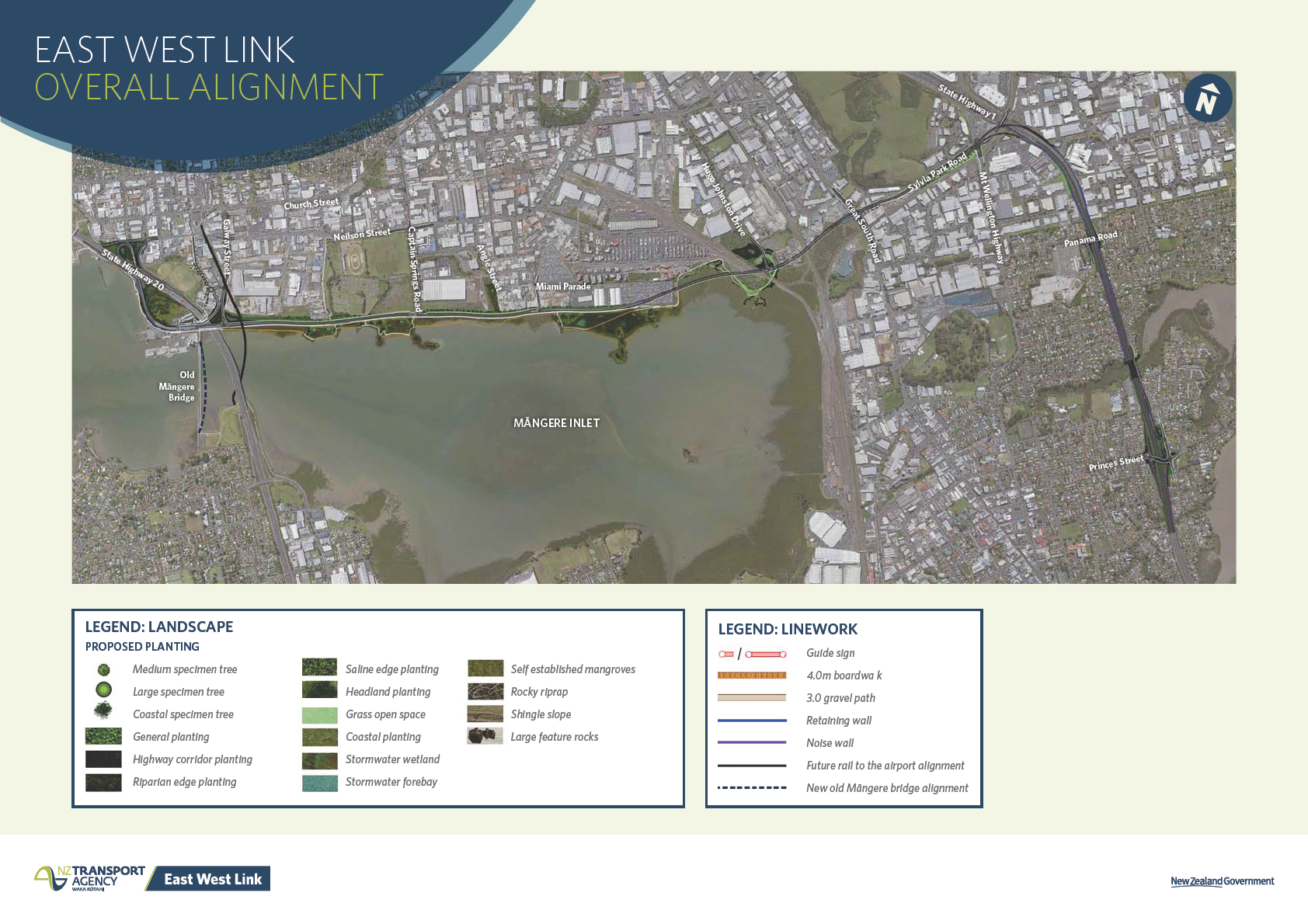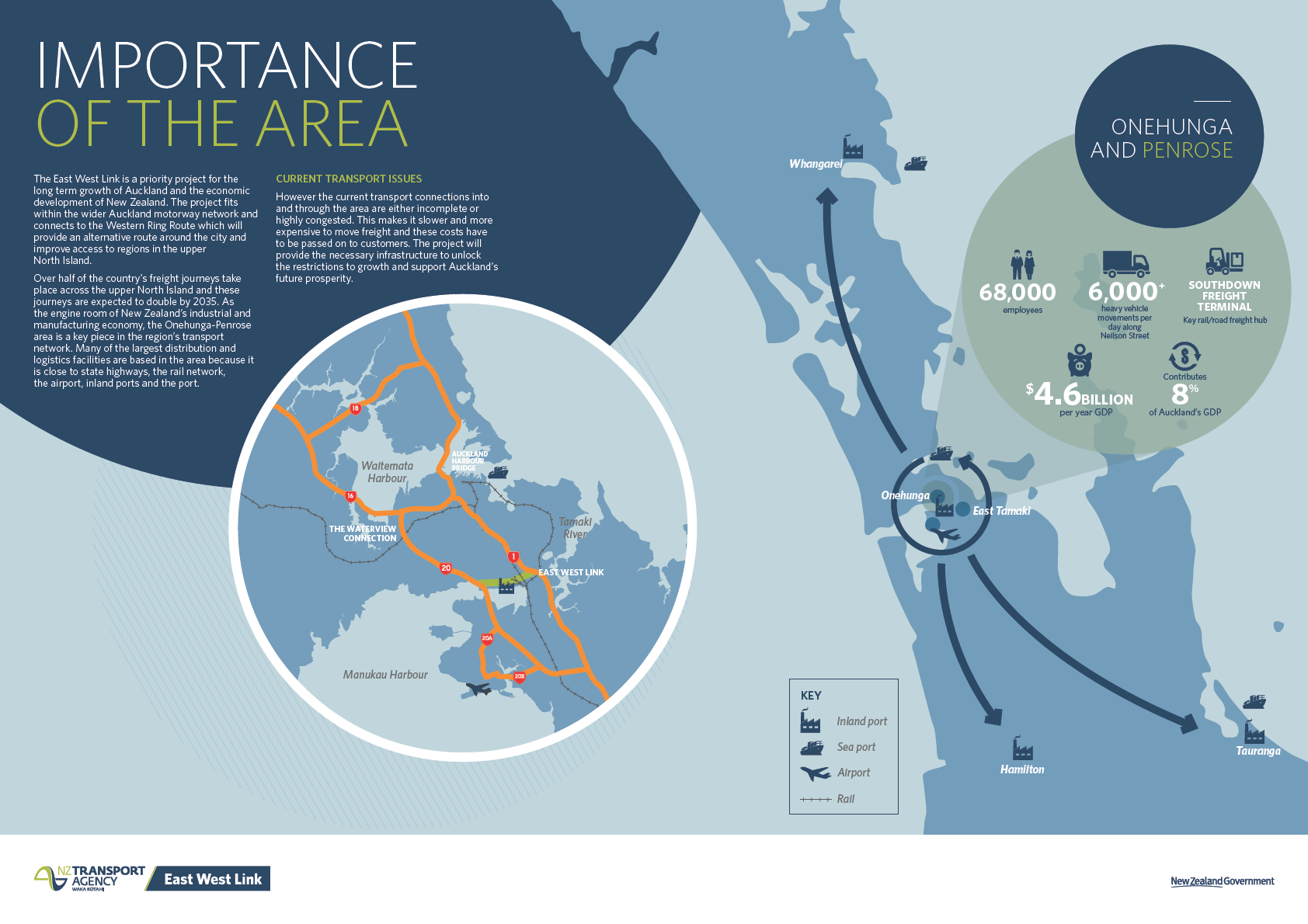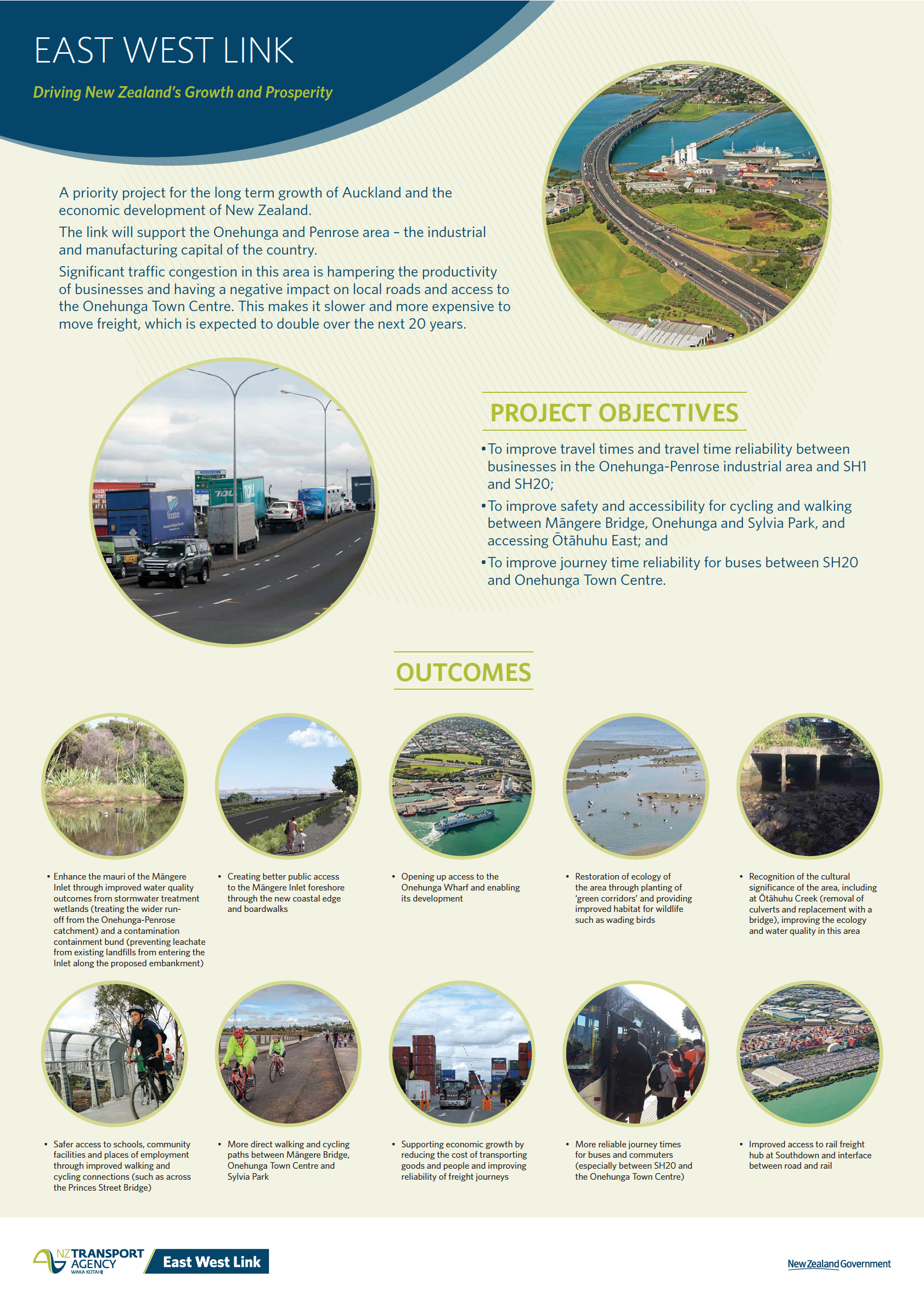

BRIEFING
Auckland East-West Link
Reason for this
To provide you with advice on giving effect to Government priorities for a
briefing
lower cost, better value Auckland East-West Link.
Action required
Sign the attached letter to the New Zealand Transport Agency Board.
Deadline
Before the scheduled Board meeting on 10 November 2017.
Reason for
To ensure the Board has your letter and can respond in time for the Ministry
deadline
to amend or develop the Government Policy Statement on land transport.
Contact for telephone discussion (if required)
Telephone
First
Name
Position
Direct line
After hours
contact
Helen White
Manager, Investment
√
Bryn Gandy
Deputy Chief
Executive, Strategy and
Investment
Withheld under section 9(2)(a) of the Official Information Act 1982
MINISTER’S COMMENTS:
Date:
1 November 2017
Briefing number:
OC05388
Attention:
Hon Phil Twyford
Security level:
In-confidence
(Minister of Transport)
Minister of Transport’s office actions
Noted
Seen
Approved
Needs change
Referred to
Withdrawn
Not seen by Minister
Overtaken by events
 Purpose of report
Purpose of report
1.
This report provides you with information on how the Auckland East-West Link (East-West
Link) project may be reviewed. It attaches a letter to the New Zealand Transport Agency
Board (the Board) seeking its views on how it would achieve the Government’s priorities for
a lower cost, better value east-west link in Auckland.
Land transport investment context
2.
The Government Policy Statement on land transport (GPS) sets out the Government’s
strategic priorities for land transport investment. The Board must ensure the National Land
Transport Programme (the Programme) gives effect to the direction in the GPS. However,
the Land Transport Management Act 2003 (the Act) does not enable you to use the GPS to
direct investment into or away from specific projects. The Board independently makes
decisions to fund specific projects using the National Land Transport Fund (the Fund).
3.
The Board’s statutorily independent functions are found in section 95(2) of the Act. Section
70 of the Act requires that the GPS is not used to direct the Board to approve or decline
funding for a particular activity or combination of activities.
4.
The effect of these two sections of the Act mean that a GPS cannot be constructed in such a
way as to remove the Board’s ability to determine which projects proceed or do not proceed
under the Programme using the Fund. Other instruments (e.g. Letters of Expectations) also
cannot be used to direct the Board in the matters that it is statutorily independent.
5.
It may be helpful to read this East-West Link report alongside our report on achieving your
priorities through the GPS that you will receive later this week. This separate report explains
the GPS mechanism, and the associated funding regime in more depth.
Auckland East-West Link
6.
The East-West Link is a proposed investment in the 2015-2018 Programme, with
construction proposed to start in 2018. The Government has signalled a preference for an
east-west link in Auckland that would cost less and have a higher benefit cost ratio than the
current East-West Link proposal.
7.
Information on the East-West Link, provided by the New Zealand Transport Agency, is
appended to this briefing.
Giving effect to a more cost effective east-west link in Auckland
8.
You have asked how to achieve the Government’s intentions for the East-West Link. Given
the independent function of the Board, we recommend that you write to the Board inviting it
to identify how it could achieve Government priorities, with a specific focus on cost effective
delivery of the East-West Link.
9.
Attached is a draft letter that invites the Board to provide its views on achieving this. To
make it clear that you are not seeking the Board’s advice on the content or development of a
GPS, the letter clarifies that you are not formally consulting or seeking advice from the
Board.
2

10.
The Ministry will consider the Board’s response. If the Board indicates impediments in the
GPS, then, depending on how quickly change is required, it may involve amending the
current GPS 2015 or including provision in a new GPS 2018.
11.
At a later point during the development of a new GPS, you may choose to confirm the
delivery of Government priorities through the Ministerial expectations in the GPS. In addition,
you may consider using the Letter of Expectations that the Minister of Transport (as
responsible Minister) typically sends to the Chair of the Board between December and
February each year.
12.
With any of these actions, it is important to ensure that the Board’s statutorily independent
functions are respected and the GPS is not used to direct the Board to approve or decline
funding for a particular activity or combination of activities.
13.
We have considered other options that could be available to you to give effect to the
Government’s priorities for the East-West Link. For example, we could amend the strategic
direction and associated funding ranges in the GPS, amend legislation to delay and require
restructuring of the East-West Link, or consider further actions under the Crown Entities Act
2004.
14.
These options are not recommended at this stage, as you are able to achieve what you seek
under the existing framework.
Allocation of savings
15.
The Government’s transport initiatives identify that $1.2 billion could be made available if a
lower cost East-West Link is progressed.
16.
Any savings to the Fund from implementing lower cost and/or more cost effective land
transport investments become available for other land transport investments and are guided
by the GPS. Decisions on the use of the Fund are made by the Board exercising its
independent powers. For example, savings may be used to accelerate existing projects in
the Programme or to bring new projects into the Programme.
17.
You could consider inviting the Board to identify what projects would progress if a
significantly lower cost option for the East-West Link achieved savings for the Programme
that were available for reallocation. The attached letter has been drafted to seek this
feedback from the Board. However, until a new GPS is issued and the Programme for 2018-
2021 is developed, it may be difficult for the Board to undertake this exercise in a meaningful
way. You may also wish to signal your interest in a further report from the Board on how it
has reprioritised projects within the Programme given Government priorities signalled in a
new GPS.
Recommendations
18.
The recommendations are that you:
(a)
invite the New Zealand Transport Agency Board to inform you on how it
Yes/No
could give effect to the Government’s priority for a lower cost, better value
east-west link in Auckland
3

(b)
sign the attached letter to Chris Moller, Chair of the New Zealand Transport
Yes/No
Agency Board
(c)
copy this briefing to the Associate Minister of Transport (Hon Julie Anne
Genter).
Yes/No
Helen White
Manager, Investment
MINISTER’S SIGNATURE:
DATE:
4

Chris Moller
Chair
New Zealand Transport Agency Board
Private Bag 6995
Wellington 6141
Dear Chris
Government priorities for land transport The Government has identified a number of areas where it is seeking change in the type of
projects and programmes that are given priority for land transport investment. One of the
priorities that the Government has identified is the Auckland East-West Link where it is
seeking a lower cost, better value option.
I am therefore writing to you to invite the Board to identify how it believes a lower cost, better
value Auckland East-West link could be achieved. This letter is not formal consultation over
any prospective GPS or seeking your advice on its development. However, I would welcome
the Board identifying how it could respond to the priority above.
I am looking to make decisions on the Government Policy Statement for land transport
(GPS) over the next few weeks. I would appreciate your reply in time for the Ministry of
Transport to advise me on any potential amendments to the GPS.
I would also welcome a report from you, once the National Land Transport Programme
2018-2021 has been developed, that identifies how the Board has prioritised and
reprioritised projects within the Programme given Government priorities signalled in the new
GPS. For my information, I would appreciate this report giving examples of the key projects
affected.
Yours sincerely
Hon Phil Twyford
Minister of Transport
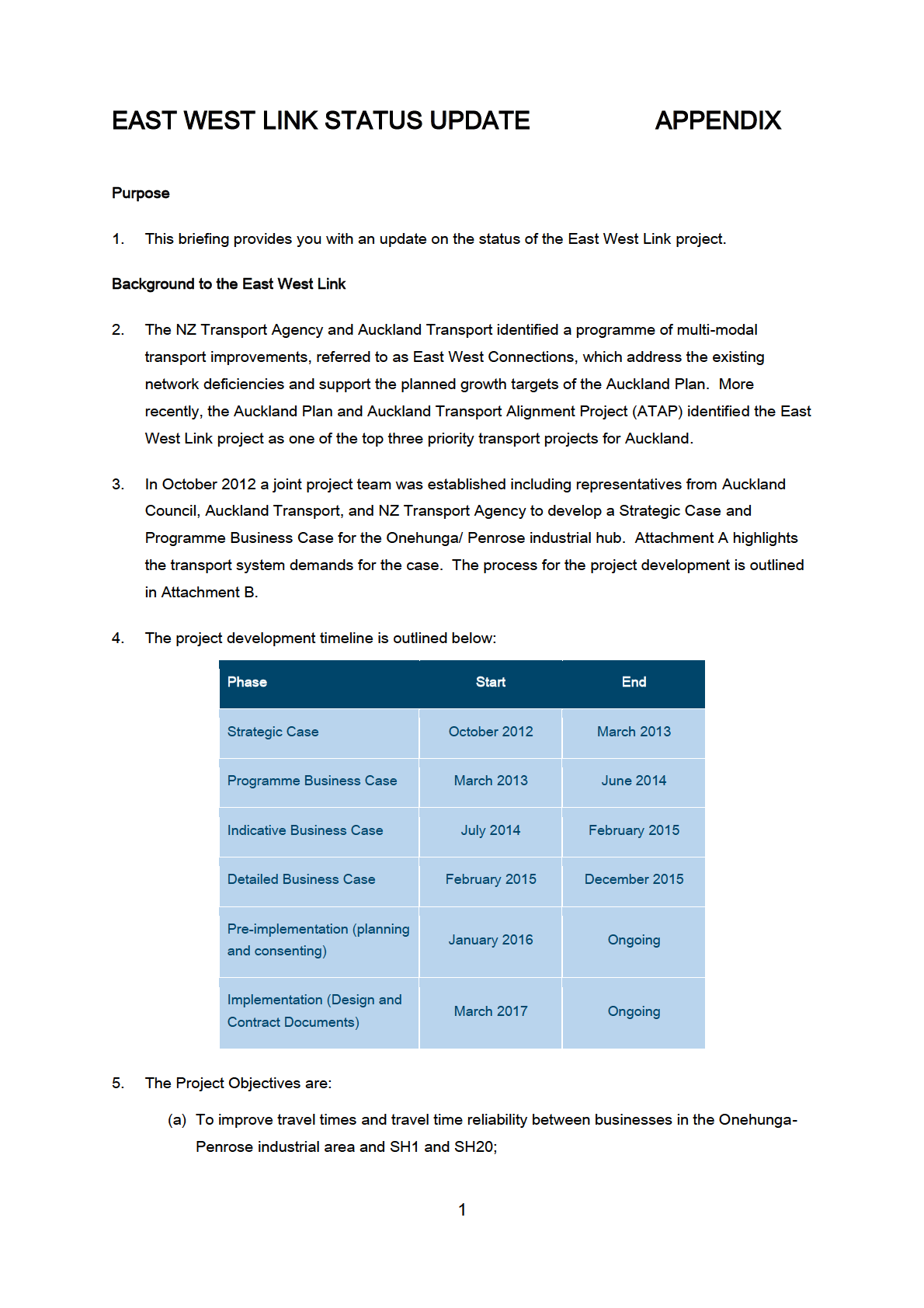



(b) To improve safety and accessibility for cycling and walking between Māngere Bridge,
Onehunga and Sylvia Park, and accessing Ōtāhuhu East; and
(c) To improve journey time reliability for buses between SH20 and Onehunga Town Centre.
NZ Transport Agency Board Approvals
6. The key NZ Transport Agency Board (Board) approvals fol owed the below timeline. These
decisions resulted in approval of implementation funding for the East West Link total ing $1.65 Bn
(in 2017 dol ars inflation adjusted). This is made up of $400m for property and $1.25 Bn for
design and construction and remains within the $1.25Bn (P5%) to $1.85Bn (P95%) range
forecast in the Detailed Business Case.
The Board of Inquiry are due to advise on the East West Link planning approvals early November
2017
7. The Board of Inquiry was established to assess the planning approvals (resource consents and
designation) for the East West Link is due to release their Draft findings to the EPA on 7
November 2017, which are required to be publically released by 14 November 2017. The ful
timeline is outlined below:
2
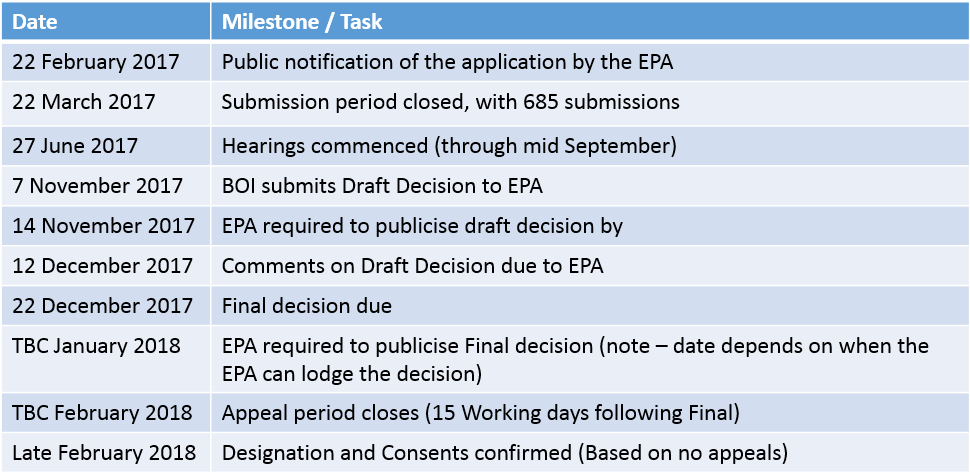

Property negotiations are wel developed
8. Landowner negotiations commenced in October 2016. Currently 38 out of 200 properties have
been secured on a wil ing buyer/seller basis, the majority along the SH1 corridor.
9. We have in principle agreement for another six properties with Public Works Act agreements yet
to be concluded. These properties total $98m (purchase price - excludes resale recoveries),
detailed in Attachment C.
10. Public Works Act Section 18 (s18) notices of desire for the required residential properties were
served in May 2017 on 22 private owners (and 1 in July) around the Princes Street area. The
s18 notices are valid for 12 months. There are currently 11 owners for the Princess St properties
for which the Transport Agency is preparing the Section 23 (compulsory acquisition) paperwork.
11. There are approximately 60 remaining landowners. The Transport Agency has been preparing
the paperwork to serve s18 notices of desire on al remaining landowners. Nine signed s18
notices have been received from LINZ but are currently on hold.
Procurement for the East West Link
12. An existing professional services contract is in place to complete the detailed design and
procurement of the East West Link. The proposed procurement has been broken down into
three contracts as indicated in Attachment D.
13. Contract 1 is proposed as a $50m traditional contract for the Princess Street Interchange area.
Design is in the final stages and is anticipated to be ready to go to market in early 2018.
3

14. Contract 2 is proposed to be a circa $500m Competitive Al iance1 contract focused on the
Onehunga interchange and foreshore works. This contract is expected to go to a shortlisting
process just prior to Christmas.
15. Contract 3 is proposed as a second al iance type procurement and includes flyovers and
interchanges from State Highway 1 through to the foreshore. This package could be up to a
$700m Competitive Al iance contract and is programmed for tender mid-2018.
16. A geotechnical investigation package of work has been prepared to inform the procurement
process and is currently on hold.
1 An alliance involves the owner (the Transport Agency), engineering consultant and
contractor entering into a contract that promotes collaborative working within an integrated
project team. Alliance participants take collective ownership and equitable sharing of all
risks associated with the delivery of the project, unlike the traditional forms of contract
where risk is allocated to different parties.
4
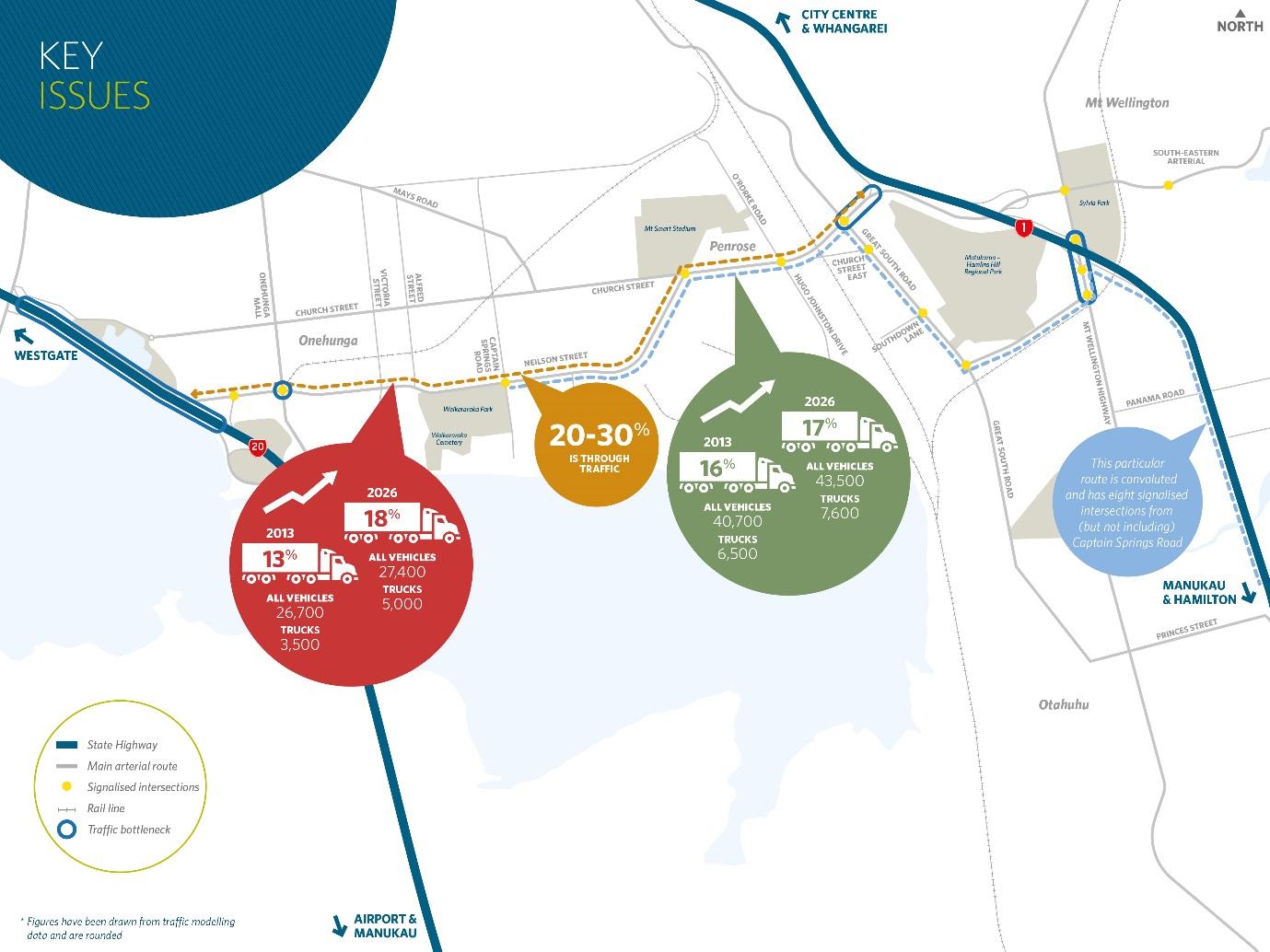

Attachment A - Key issues (and future freight trends) in the Onehunga Penrose Area
